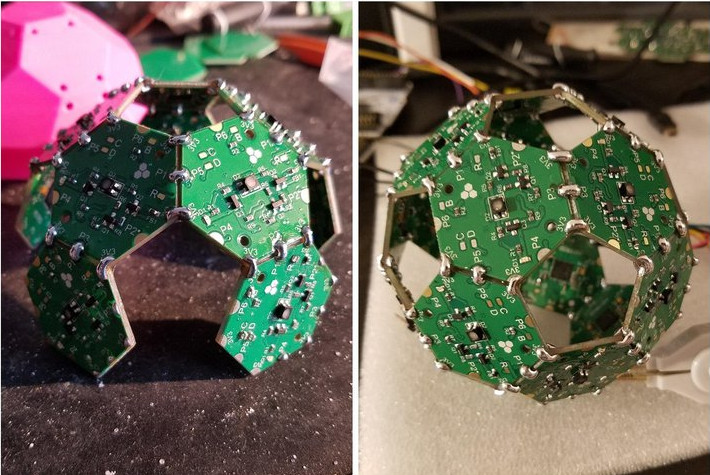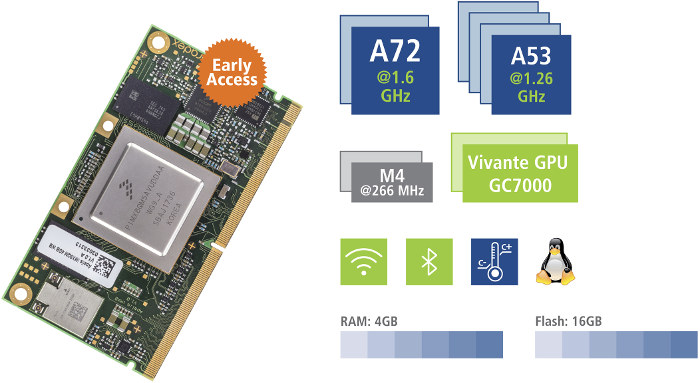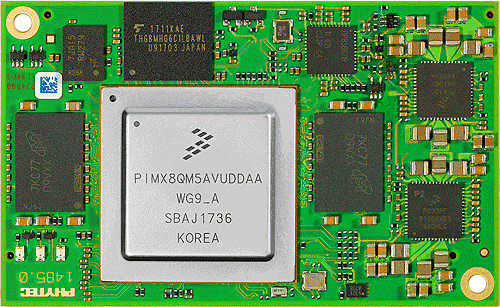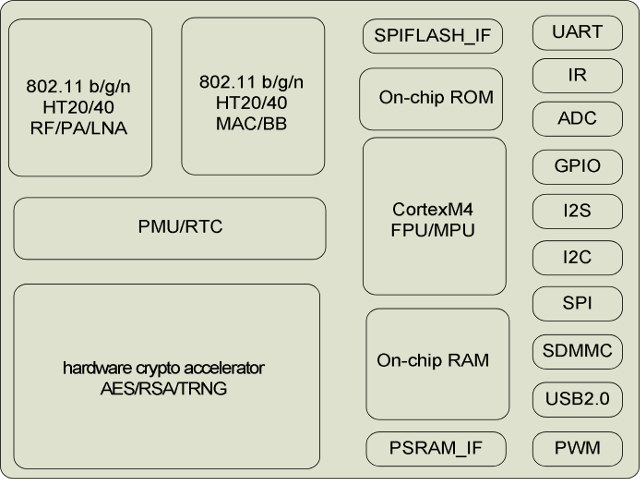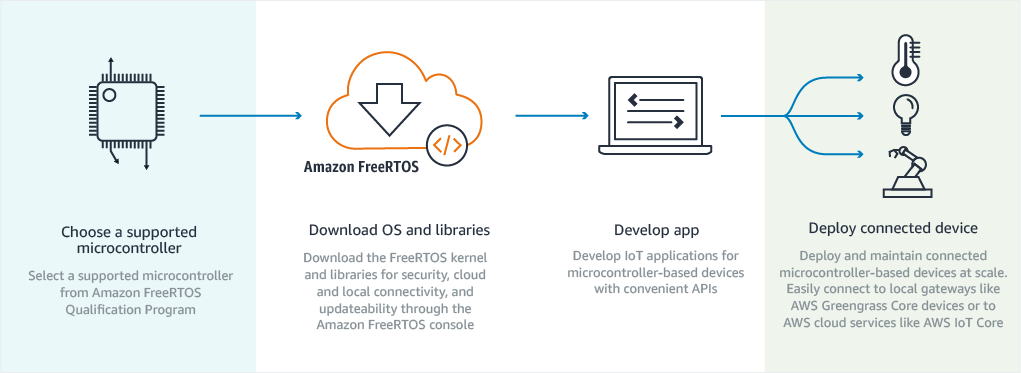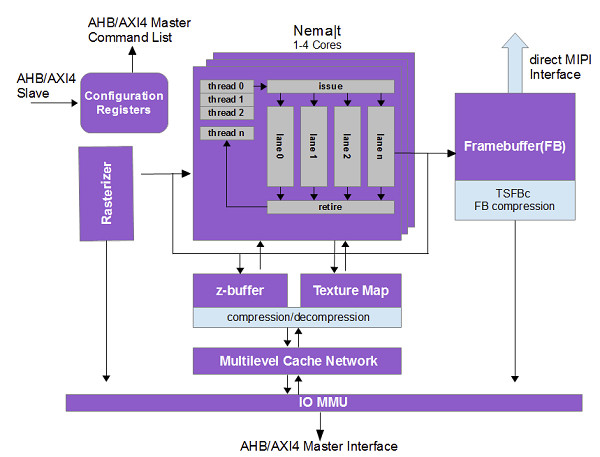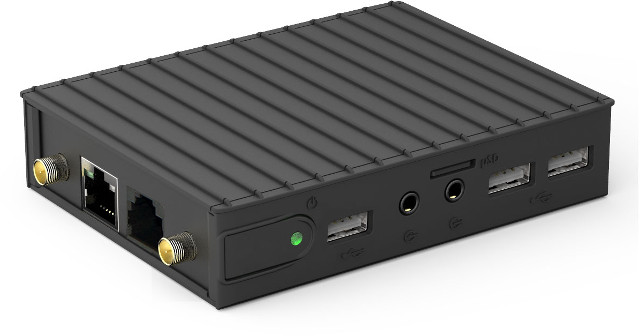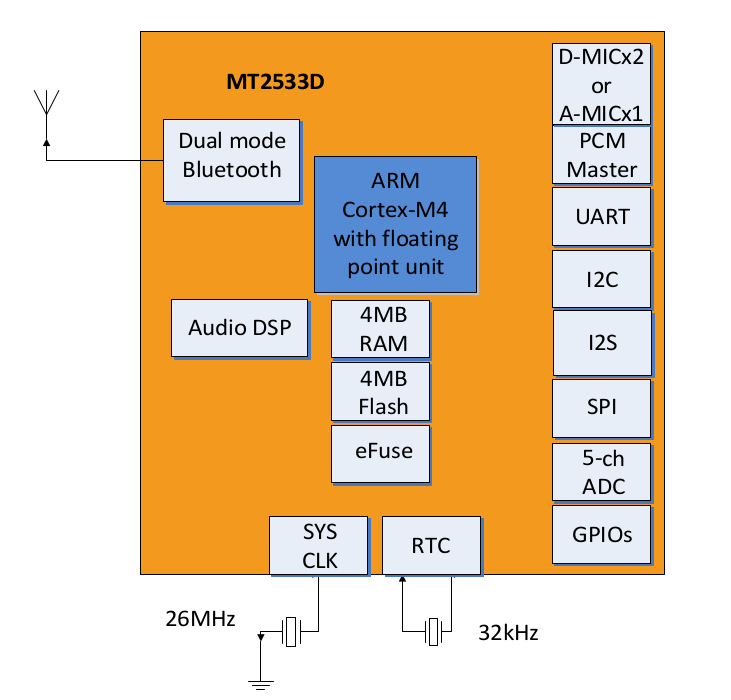A few years ago, I made a Raspberry Pi case made of perfboard and created some sort of DIY modular 3D electronics design by using the top and sides of the case to also hold electronics components and associated circuitry like a relay, and LEDs. The just launched Hexabitz hexagonal / pentagonal modules are designed to make prototyping easier, and also provide flexibility to create all sort of wire-free (3D) electronics designs with minimal soldering. A little over a dozen of modules are currently on offer, most with an STM32F0 Arm Cortex M0 micro-controller: Modules with built-in MCU 01R00, P01R00 – RGB LED (hexagon / pentagon) with Cree Tri-color (RGB) SMD LED, 4-Pin PLCC H02R10 – Bluetooth/BLE V4 based on Laird BT900-SA + chip antenna, +8 dBm max H04R00 – Audio amplifier, speaker, and headphone jack based on ST TS4990IST 1.2W audio power amplifier, 0.7W, 8 Ohm speaker H05R00 – SPI […]
Toradex Launches Apalis iMX8 Computer-on-Module based on NXP i.MX 8QuadMax SoC
Toradex Apalis iMX8 is another system-on-module powered by NXP i.MX 8QuadMax hexa core Arm Cortex A72 + 53 processor, which comes with 4GB LPDDR4 RAM, up to 16GB flash, and an on-board dual-band 802.11ac 2×2 MU-MIMO Wi-Fi and Bluetooth 5 ready module. The company has just opened early access for selected customers, so it has become possible to start developing products with the MXM3 computer-on-module. Apalix i.MX8 module specifications: SoC – NXP i.MX 8QuadMax hexa core processor with 2x Arm Cortex-A72 cores @ 1.6 GHz, 4x Arm Cortex-A53 cores @ 1.26 GHz, 2x Cortex-M4 real-time core @ 266 MHz, and dual Vivante GC7000XSVX GPU System Memory – 4GB LPDDR4 (64 Bit) Storage – Up to 16GB eMMC flash On-module Connectivity Gigabit Ethernet via Microchip KSZ9031 transceiver with low power features Dual-band 802.11ac 2×2 MU-MIMO Wi-Fi and Bluetooth 5 via Azurewave AW-CM276NF M.2 1216 LGA module Audio – NXP SGTL5000 low […]
PHYTEC Introduces phyCORE SoMs & Devkits Based on NXP i.MX8, i.MX 8M, or i.MX 8X Processors
PHYTEC, an embedded systems company headquartered in Germany with global offices, has updated their phyCORE systems-on-module family with 3 sub-families of modules based on NXP i.MX 8, i.MX 8X, or i.MX 8M dual or quad core processors for a total of 9 modules. phyCORE-i.MX 8 Specifications: SoC – NXP i.MX 8Quad, i.MX 8QuadPlus or i.MX 8QuadMax Arm Cortex-A72/A53/M4F processor @ up to 1.6 GHz with Tensilica HiFi 4 DSP @ 666 MHz, 2x Vivante GC7000XSVX GPUs System Memory – 1 to 8GB LPDDR4 RAM Storage – 64MB to 256MB Octal SPI/DualSPI SPI NOR Flash, 4 GB to 128 GB eMMC flash, 4kB EEPROM Connectivity – 2x Gigabit Ethernet PHY 4x 120-pin Board-to-board connectors with: Display – 2x LVDS, 2x MIPI DSI, 1x HDMI Video Input / Camera – 1x HDMI, 2x MIPI CSI Audio – 2x ESAI, up to 4x SAI Networking – 2x 10/100/1000 Mbit/s Ethernet USB – 1x […]
$1 RDA5981 WiFi IoT Arm Cortex-M4 SoC is Designed for Smart Home Devices, Smart Speakers
RDA Microelectronics processors are found in a few cheap smart and not-so-smart phones, as well as the even cheaper Orange Pi i96 board. But the company does not only design cellular chips, but their portfolio also includes solutions for the Internet of Things and TV & radio tuners. RDA5981 is a WiFi IoT chip specifically designed for smart home & audio application, such as smart speakers, and it’s found in devices running Baidu DuerOS, the Chinese equivalent of Amazon Alexa or Google Assistant. The company explains it can be widely used in televisions, set-top boxes, smart appliances, wireless monitors, and other products. RDA5981 A/B/C processor specifications: CPU – Arm Cortex-M4 @ up to 160 MHz with integrated MPU and mbed uvisor System Memory – Up to 448 KB SRAM for network stack and application, external PSRAM interface Storage – Up to 32Mbit SPI flash Connectivity WiFi 2.4 Ghz 802.11b/g/n WiFi […]
Amazon FreeRTOS Released for NXP, Texas Instruments, STMicro, and (soon) Microchip Microcontrollers
FreeRTOS is an open source real-time operating system for microcontrollers released under an MIT license, and when it comes to adoption in embedded systems it’s right there near the top with embedded Linux according to Aspencore 2017 embedded markets study. For example, some Espressif SDKs for ESP8266 or ESP32 are based on FreeRTOS, and so is Mediatek LinkIt Development Platform for RTOS. The recently announced Amazon FreeRTOS (a:FreeRTOS) leverages the open source operating systems, and extends it with with libraries that enable local and AWS cloud connectivity, security, and soon over-the-air updates. a:FreeRTOS is free of charge, open source, and available today. In order to get started, you’ll have a choice of 4 hardware platforms: STMicro STM32L4 Discovery Kit IoT Node (B-L475E-IOT01A) powered by STM32L475 ARM Cortex-M4 MCU with 802.11 b/g/n WiFi, Bluetooth 4.1 LE, RF (868 / 915 MHz), and NFC connectivity, plenty of sensors NXP LPC54018 IoT module (OM40007) […]
Think Silicon Ultra Low Power NEMA GPUs are Designed for Wearables and IoT Applications
When you have to purchase a wearable device, let’s say a smartwatch or fitness tracker, you have to make trade offs between user interface and battery life. For example, a fitness tracker such as Xiaomi Mi Band 2 will last about 2 weeks per charge with a limited display, while Android smartwatches with a much better interface need to be recharged every 1 or 2 days. Think Silicon aims to improve battery life of the devices with nicer user interfaces thanks to their ultra-low power NEMA 2D, 3D, and GP GPU that can be integrated into SoCs with ARM Cortex-M and Cortex-A cores. The company has three family of GPUs: NEMA|p pico 2D GPU with one core 4bpp framebuffer, 6bpp texture with/out alpha Fill Rate – 1pixel/cycle Silicon Area – 0.07 mm2 with 28nm process Power Consumption – leakage power GPU consumption of 0.06mW; with compression (TSFSc): 0.03 mW NEMA|t […]
Compulab IOT-GATE-iMX7 is an NXP i.MX7 IoT Gateway for Industrial Applications
CompuLab has introduced IOT-GATE-iMX7 compact fanless IoT gateway and industrial controller built around the company’s CL-SOM-iMX7 system-on-module, and offering Ethernet, WiFi, Bluetooth, 3G and Zigbee connectivity.Compulab IOT-GATE-iMX7 gateway specifications: SoC – NXP i.MX 7 dual ARM Cortex-A7 processor @ up to 1GHz with ARM Cortex-M4 core @ 200Mhz, 2D graphics engine System Memory – Up to 2GB DDR3L-1066 Storage – Up to 32GB on-board eMMC + micro-SD socket Connectivity Dual Gigabit Ethernet Dual band WiFi 802.11 a/b/g/n Bluetooth 4.1 BLE Optional 3G cellular module via mini PCie socket Optional ZigBee NXP JN5168 module Display – DVI up to 1920×1080 using a HDMI connector Audio – 3.5mm jacks for stereo line out, stereo line in USB – 4x USB2.0 host ports, type-A connectors Serial – 1x RS485 / RS422 port, RJ11 connector; 1x RS232 port, ultra-mini serial connector; 1x serial console via UART-to-USB bridge, micro-USB connector Expansion mini-PCIe socket, full-size embedded […]
Mediatek MT2533D is a Bluetooth 4.2 SiP for Smart Headphones & Hands-Free Systems
There used to be a time when most products were based on a general purpose MCU or processor that you would interface to over chips like audio codecs, memory chips, flash storage, etc…, but in order to cut costs, application specific SoCs have become quite common over the year, so we’ve had mobile application processors for several years already, but more recently we got “wearables” SoCs and “Smart Home” SoCs, and Mediatek has launched MT2533D “headphone” SiP (System-in-Package) combining a Cortex-M4 MCU, 4MB PSRAM, an audio codec, and a dual mode Bluetooth subsystem. Mediatek MT2533D specifications: MCU – ARM Cortex-M4 @ up to 208MHz with 32KB L1 cache, FPU, MPU, AES 128/192/256 crypto engine and TRNG Memory – 160kB SRAMs, 4MB pseudo SRAM Storage – 4MB flash Wireless Connectivity – Bluetooth 4.2 dual mode (classic and low energy) Audio AAC/SBC for Bluetooth audio CVSD/mSBC for Bluetooth speech PCM playback: 8-48kHz […]


